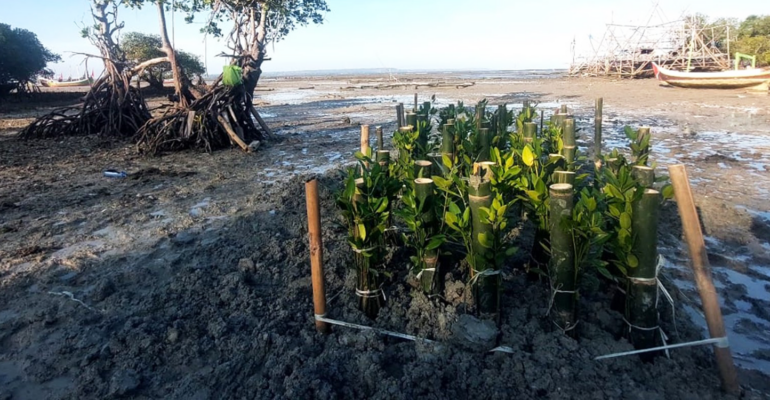SiTampan: Mangrove Planting Method for Extreme Conditions, A Synergy Between IPB University Lecturers and Pokmaswas Reng Paseser

IPB University and the Community Monitoring Group (Pokmaswas) Reng Paseser have tested a new method for mangrove planting called ‘SiTampan’. This activity is part of IPB University’s Dosen Pulang Kampung (Dospulkam) program in 2024.
The project, led by Fery Kurniawan, a lecturer in the Department of Aquatic Resources Management (MSP) at IPB University, was conducted at Kundang Wetan Beach, Tanjung Village, Saronggi District, Sumenep Regency, Madura.
“A total of 560 Rhizopora stylosa seedlings were planted using the SiTampan method. SiTampan stands for Clustered Stake Planting System. This method combines the stake mangrove planting method with the cluster method,” explained Fery.
The planting took place in the afternoon with the participation of all Pokmaswas members and community members who volunteered to help and learn together. The chief of Tanjung Village, a teacher from SDN 1 Tanjung, and community leaders also attended the event.
Fery Kurniawan stated that this method is still in the testing phase. He hopes that this method will trap more sediment or sand and nutrients compared to other methods.
“SiTampan can potentially serve as a natural wave barrier (APO) because of its clustered and dense planting system, which is strong enough to withstand coastal waves and currents. We hope that SiTampan will be successful and applicable to beaches with extreme conditions,” he added.
Fery further explained that SiTampan was developed through discussions and collaboration between IPB University and Pokmaswas Reng Paseser. This method was created in response to the strong back-and-forth waves in the mangrove planting area due to seawalls and the limited nutrients in the substrate, which is dominated by fractured muddy coral.
“With SiTampan, it is hoped that more sediment will be trapped, providing more nutrients for the mangroves. More nutrients will help accelerate the growth of mangrove seedlings,” said the senior researcher at the Coastal and Marine Resources Study Center (PKSPL) IPB University.
Fatlillah, commonly known as Fadel, the secretary of Pokmaswas Reng Paseser, explained that SiTampan is the fifth method developed and tested at Kundang Wetan.
“Looking at the condition of the mangroves from previous methods, the clustered system seems to be more successful compared to the conventional method where the plants are planted individually,” he added.
The community was very enthusiastic about using the SiTampan method, as this was their first experience with it. Furthermore, there were many bamboo remnants from seaweed rafts around the planting area, which contributed to the damage to the planted mangroves, in addition to trash. The community hopes that SiTampan will become a tool for trapping and holding back the waves.
In addition to testing the SiTampan method, the Dospulkam program in Tanjung Village also included the launch of mangrove tea, as well as training and monitoring of the mangroves that had already been planted. (*/RZ) (IAAS/RUM)



